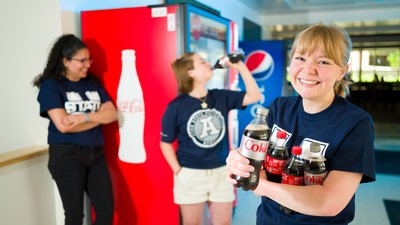Snug as a Bug: USU Biologist's Work Featured in 'National Geographic'
Recent findings about a tiny insect that harbors two microbes it couldn’t survive without reveals a striking glimpse of how all organisms evolve.
Utah State University biologist Carol von Dohlen discovered the three-tiered symbiotic relationship of citrus mealybugs and two bacterial partners, Tremblaya princeps and Moranella endobia, back in 2001 and reported the findings in Nature.
“To our knowledge, this was the first documented report of intracellular symbiosis involving two species of bacteria,” says von Dohlen, professor in USU’s Department of Biology and the USU Ecology Center.
Her 2001 research and subsequent findings are featured in the June 20, 2013, issue of National Geographic Magazine’s Phenomena science salon.
Close cousins of aphids, mealybugs feed on sweet plant sap but are unable to convert the sugary substance into life-sustaining protein. The insects’ two bacterial residents work in tandem to convert the sap to amino acids, the building blocks of protein, to nourish their host.
“So we discovered the interdependence of these three organisms, none of which could survive without the others,” von Dohlen says. “But we didn’t know exactly how this weird association worked.”
Enter microbiologist John McCutcheon of the University of Montana, who teamed with von Dohlen to sequence the bacteria’s genomes and piece together each microbe’s role in the trio’s communal survival. The team’s findings appeared in the Aug. 11, 2011, online edition of Current Biology.
To conduct the study, von Dohlen painstakingly extracted DNA from each bacterial partner by dissecting organs from the tiny bugs.
“It was very delicate work,” she says. “I used a dissecting scope. Each mealybug is only a couple of millimeters long.”
McCutcheon, assistant professor in UM’s Division of Biological Sciences, conducted the meticulous process of mapping each bacterium’s genes and their functions. His findings reveal that each bacterium has a very small, simple genome.
“The results are intriguing,” von Dohlen says. “We discovered that each bacterium handles different steps of the mealybug’s metabolic pathway and they don’t duplicate efforts. Furthermore, we discovered that the mealybug also has a gene that contributes to this process that the bacteria don’t possess. This may be the first documented evidence of this kind of triple ‘tag-team’ relationship.”
The simple genomes and complementary nature of these microbes suggests that each partner has lost genes as they’ve settled into a comfortable, symbiotic environment, she says.
“Metabolic pathways that parallel and complement each other have been found in other organisms,” von Dohlen says. “But to find one interdependent pathway where each partner has specific, unduplicated roles is extraordinary.”
The findings, she says, shed light on the development of organelles: semi-independent units found inside the cells of all living things that possess a tiny portion of their own DNA and perform varied functions.
“Our studies could help us understand the evolution of mitochondria and other organelles essential for each living cell’s survival,” von Dohlen says.
Related links:
- “USU Researchers Discover Bacteria within Bacteria,” Utah State Today
- USU Department of Biology
- USU Ecology Center
- USU College of Science
Contact: Carol von Dohlen, 435-797-2549, carol.vondohlen@usu.edu
Writer: Mary-Ann Muffoletto, 435-797-3517, maryann.muffoletto@usu.edu
USU professor Carol von Dohlen's research on mealybugs and their symbiotic relationships with bacteria is featured in National Geographic’s 'Phenomena’ publication.
von Dohlen says mealybugs, close cousins of aphids, host two kinds of bacteria critical to the insects' survival. Her research reveals clues about the evolution of all organisms.
TOPICS
Genetics 63storiesComments and questions regarding this article may be directed to the contact person listed on this page.







